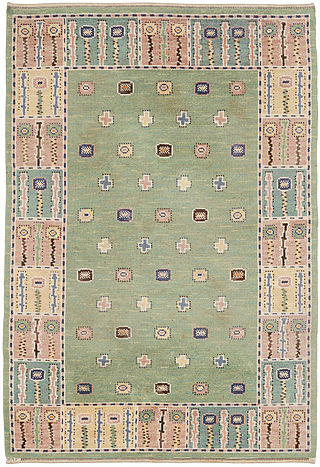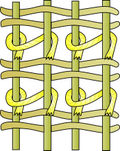
A loom is a device used to weave cloth and tapestry. The basic purpose of any loom is to hold the warp threads under tension to facilitate the interweaving of the weft threads. The precise shape of the loom and its mechanics may vary, but the basic function is the same.

A carpet is a textile floor covering typically consisting of an upper layer of pile attached to a backing. The pile was traditionally made from wool, but since the 20th century synthetic fibers such as polypropylene, nylon, or polyester have often been used, as these fibers are less expensive than wool. The pile usually consists of twisted tufts that are typically heat-treated to maintain their structure. The term carpet is often used in a similar context to the term rug, but rugs are typically considered to be smaller than a room and not attached to the floor.
Ikat is a dyeing technique from Indonesia used to pattern textiles that employs resist dyeing on the yarns prior to dyeing and weaving the fabric. The term is also used to refer to related and unrelated traditions in other cultures. In Southeast Asia, where it is the most widespread, ikat weaving traditions can be divided into two general clades. The first is found among Daic-speaking peoples. The second, larger group is found among the Austronesian peoples and spread via the Austronesian expansion. Similar dyeing and weaving techniques that developed independently are also present in other regions of the world, including India, Central Asia, Japan, Africa, and the Americas.

A Persian carpet or Persian rug, also known as Iranian carpet, is a heavy textile made for a wide variety of utilitarian and symbolic purposes and produced in Iran, for home use, local sale, and export. Carpet weaving is an essential part of Persian culture and Iranian art. Within the group of Oriental rugs produced by the countries of the "rug belt", the Persian carpet stands out by the variety and elaborateness of its manifold designs.

A kilim is a flat tapestry-woven carpet or rug traditionally produced in countries of the former Persian Empire, including Iran, the Balkans and the Turkic countries. Kilims can be purely decorative or can function as prayer rugs. Modern kilims are popular floor coverings in Western households.

Knot density is a traditional measure for quality of handmade or knotted pile carpets. It refers to the number of knots, or knot count, per unit of surface area - typically either per square inch (kpsi) or per square centimeter (kpsc), but also per decimeter or meter. Number of knots per unit area is directly proportional to the quality of carpet. Density may vary from 25 to 1,000 knots per square inch or higher, where ≤80 kpsi is poor quality, 120 to 330 kpsi is medium to good, and ≥330 kpsi is very good quality. The inverse, knot ratio, is also used to compare characteristics. Knot density = warp×weft while knot ratio = warp/weft. For comparison: 100,000/square meter = 1,000/square decimeter = 65/square inch = 179/gereh.

A Yürük rug is a traditional tribal rug woven in Anatolia by the Yörüks, a Turkish ethnic subgroup.
An oriental rug is a heavy textile made for a wide variety of utilitarian and symbolic purposes and produced in "Oriental countries" for home use, local sale, and export.

Pile weave is a form of textile created by weaving. This type of fabric is characterized by a pile—a looped or tufted surface that extends above the initial foundation, or 'ground' weave. The pile is formed by supplemental yarn running in the direction of the length of the fabric or the width of the fabric. Pile weaves include velvet and corduroy fabrics and machine-woven Berber carpets.

Anatolian rug is a term of convenience, commonly used today to denote rugs and carpets woven in Anatolia and its adjacent regions. Geographically, its area of production can be compared to the territories which were historically dominated by the Ottoman Empire. It denotes a knotted, pile-woven floor or wall covering which is produced for home use, local sale, and export. Together with the flat-woven kilim, Anatolian rugs represent an essential part of the regional culture, which is officially understood as the Culture of Turkey today, and derives from the ethnic, religious and cultural pluralism of one of the most ancient centres of human civilisation.
The manufacture of textiles is one of the oldest of human technologies. To make textiles, the first requirement is a source of fiber from which a yarn can be made, primarily by spinning. The yarn is processed by knitting or weaving, which turns yarn into cloth. The machine used for weaving is the loom. For decoration, the process of colouring yarn or the finished material is dyeing. For more information of the various steps, see textile manufacturing.

Hereke carpets are Turkish handmade carpets produced and sold in Hereke, a coastal town in Turkey. For a long time, they were produced only in Hereke, 60 km from Istanbul. The materials used are silk, a combination of wool and cotton, and sometimes gold or silver threads.
A Pakistani rug, also known as Pakistani carpet, is a type of handmade floor-covering heavy textile traditionally made in Pakistan and is used for a wide variety of utilitarian and symbolic purposes. Rug/carpet weaving is an essential part of Pakistani culture and Pakistani art.

Kerman carpets are one of the traditional classifications of Persian carpets. Kerman is both a city and a province located in south central Iran. The term also sometimes describes a type which may have been made elsewhere. Typical manufacturing techniques use an asymmetrical knot on cotton foundation, but less frequent examples incorporate silk or part silk piles, or silk foundations with wool pile.

Soumak is a tapestry technique of weaving sturdy, decorative fabrics used for carpets, rugs, domestic bags and bedding, with soumak fabrics used for bedding known as soumak mafrash.
Varamin carpets and rugs or Veramin carpets and rugs are carpets and rugs woven in city of Varamin and its surrounding area, southeast of Tehran. Many rug and carpet experts see Varamins as being among those Persian carpets most authentic in terms of traditional style and motif.

Carpets and rugs have been handmade in Sweden for centuries, taking on many different forms and functions over the course of time. Rugs woven in the traditional Oriental manner, especially in the Ottoman Empire and points east, were originally brought to Sweden over trade routes as early as the early Middle Ages. In the centuries that followed, Swedish rug-makers often infused their works with themes and motifs traditionally found in Oriental rugs. Eventually, Swedish rug-makers would begin to use Oriental rug-making techniques, but themes and motifs more consistent with the artistic and cultural heritage of Sweden. By the early modern periods, rugs had long been an important avenue of art – especially folk art – in Swedish culture. By the beginning of the twentieth century, the craft was seen as being an important artistic and cultural practice throughout Sweden, and designers began to make rugs that had a broad international appeal. Swedish rugs from the mid-twentieth century remain among the most desirable and sought after in the rug world.

The Oriental Carpet Manufacturers (OCM) was a London-based company involved in the production of, and trade with, Oriental carpets. Established in 1907/8 in Istanbul, the company set up and controlled their own carpet manufactures in the central Anatolian region around the town of Konya, and from 1911 onwards, in the Hamadan Province in northwestern Iran. In 1968 it was sold, and merged with one of its former affiliates, the Eastern Kayyam Company. From 1924 until 1948, OCM was led by Arthur Cecil Edwards, who, after retiring, wrote a text book on Persian Carpets, which is still in print today.

A lazy line or section line is a technical feature of weaving which describes visible diagonal joins within a woven textile. It results from interlacing wefts joining adjacent warp sections woven at different times. Successive rows of turnarounds of discontinuous wefts create a diagonal line which, in pile rugs, is best seen from the back side, and from the front side only if the pile is heavily worn. A lazy line is created when the weaver does not finish a rug line by line from one side to the other, but sequentially finishes one area after the other.
Qaleen is a type of hand knotted piled carpet. The term is used throughout Turkey, Iran and Central Asia, and making qaleens is currently practised as a handicraft in Turkey and Iran. Artisans may need at least two months to make one qaleen. The craft was learned from Persians by the artisans of Kashmir on the Indian subcontinent. These knotted pile carpets so were a blend of Persian and Indian craftsmanship. ''Qaleens'' or ''Ghalichas'' were made in the Kashmir region of India and Pakistan.
























